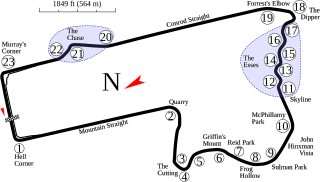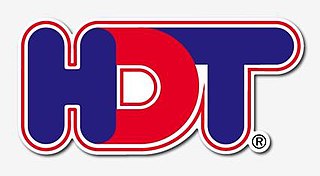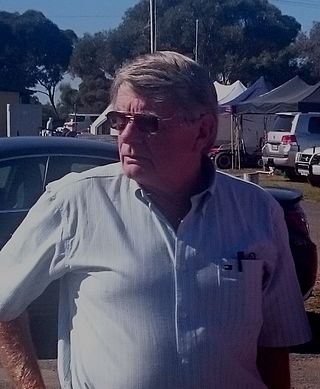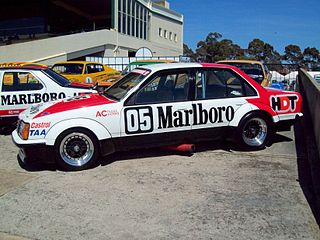
The Triumph Dolomite was a small saloon car produced by the Triumph Motor Company division of the British Leyland (BL) in Canley, Coventry, between October 1972 and August 1980.

The Bathurst 1000 is a 1,000-kilometre (621.4 mi) touring car race held annually on the Mount Panorama Circuit in Bathurst, New South Wales, Australia. It is currently run as part of the Supercars Championship, the most recent incarnation of the Australian Touring Car Championship. In 1987 it was a round of the World Touring Car Championship. The Bathurst 1000 is colloquially known as The Great Race among motorsport fans and media. The race originated with the 1960 Armstrong 500 with a 500 mile race distance at the Phillip Island Grand Prix Circuit; it was relocated to Bathurst in 1963 also with the 500 mile distance and has continued there every year since extending to a 1,000 kilometer race in 1973. The race was traditionally run on the New South Wales Labour-Day long weekend in early October. Since 2001, the race has been run on the weekend following the long weekend, generally the second weekend of October.

Jim Richards is a New Zealand racing driver who won numerous championships in his home country and in Australia. While now retired from professional racing, Richards continues to compete in the Touring Car Masters series.

The Holden Dealer Team (HDT) was Holden's semi-official racing team from 1969 until 1986, primarily contesting Australian Touring Car events but also rallying, rallycross and Sports Sedan races during the 1970s. From 1980 the Holden Dealer Team, by then under the ownership of Peter Brock, diversified into producing modified road-going Commodores and other Holden cars for selected dealers via HDT Special Vehicles.

Colin John Bond is an Australian former racing driver. Bond reached the highest levels in Australian motorsport in 1969 when he was recruited by Harry Firth to the newly formed Holden Dealer Team. He quickly found success, winning the 1969 Hardie-Ferodo 500 mile race at Bathurst, New South Wales in a Holden Monaro.
John GossOAM is an Australian retired motor racing driver who competed in his home country during the 1960s, 1970's and 1980's. He is the only driver to have won Australia's two most prestigious races, the Bathurst 1000, and the Australian Grand Prix (1976).

Allan Maxwell Grice, known to motor-racing fans as "Gricey", is an Australian former racing driver and politician, most famous for twice winning the prestigious Bathurst 1000, and as a privateer driver of a Holden in the Australian Touring Car Championship.

The 1975 Hardie-Ferodo 1000 was the 16th running of the Bathurst 1000 touring car race. It was an endurance race for touring cars complying with CAMS Group C regulations. The event was held at the Mount Panorama Circuit just outside Bathurst, New South Wales on 5 October 1975 over a distance of 1006.036 km. The race was Round 3 of the 1975 Australian Manufacturers' Championship.
Robert Morris is an Australian former racing driver. Morris was one of the leading touring car drivers during the 1970s and continued racing until 1984. Morris won Australia's premier Touring car race, the Bathurst 1000 in 1976. He also won the Australian Touring Car Championship in 1979. Morris was inducted into the V8 Supercars Hall of Fame in 2004.
The Ford works team was the unofficial name for an Australian motor racing team which was supported by the Ford Motor Company of Australia. The team was formed in 1962 and was disbanded when Ford Australia withdrew from motor racing at the end of 1973. Drivers for the works team included Allan Moffat, Fred Gibson, Harry Firth, Bob Jane, Barry Seton, Bruce McPhee, John French, Ian Geoghegan and his brother Leo Geoghegan. Ford Australia also supported a factory rally team in Australia from 1977 to 1980.

The 1980 Hardie-Ferodo 1000 was the 21st running of the Bathurst 1000 touring car race. It was held on 5 October 1980 at the Mount Panorama Circuit just outside Bathurst in New South Wales, Australia. The race was open to cars eligible under the locally developed CAMS Group C Touring Car regulations with four engine capacity based classes.

The 1979 Hardie-Ferodo 1000 was the 20th running of the Bathurst 1000 touring car race. It was held on 30 September 1979, at the Mount Panorama Circuit just outside Bathurst. The race was open to cars eligible to the locally developed CAMS Group C touring car regulations with four engine capacity based classes.

The 1978 Hardie-Ferodo 1000 was the 19th running of the Bathurst 1000 touring car race. It was held on 1 October 1978, at the Mount Panorama Circuit just outside Bathurst. The race was open to cars eligible to the locally developed CAMS Group C touring car regulations with three engine capacity based classes.

The 1977 Hardie-Ferodo 1000 was a motor race for Group C Touring Cars, held on 2 October 1977 at the Mount Panorama Circuit just outside Bathurst in New South Wales, Australia. It was the 18th in a sequence of "Bathurst 1000" events commencing with the 1960 Armstrong 500.

The 1976 Hardie-Ferodo 1000 was the 17th running of the Bathurst 1000 touring car race. It was held on 3 October 1976 at the Mount Panorama Circuit just outside Bathurst in New South Wales, Australia. The race was open to cars complying with CAMS Group C Touring Car regulations.

The 1974 Hardie-Ferodo 1000 was an endurance race for Group C Touring Cars, held at the Mount Panorama Circuit near Bathurst in New South Wales, Australia on 6 October 1974. The race was Round 3 of the 1974 Australian Manufacturers' Championship and was the 15th in a sequence of annual “Bathurst 1000” races commencing with the 1960 Armstrong 500.

The 1973 Hardie-Ferodo 1000 was the 14th running of the Bathurst 1000 touring car race. This was the first race to be held under the new metricised distance of 1000 kilometres, rather than the 500 miles previously contested. It was held on 30 September 1973 at the Mount Panorama Circuit just outside Bathurst in New South Wales, Australia. The race was open to Group C Touring Cars competing in four engine capacity based classes. It was the third round of the 1973 Australian Manufacturers' Championship.
John Francis Harvey was an Australian racing driver. He was a top Speedcar driver for many years in the 1950s and 1960s, winning many championship races including the NSW Championship for three successive years and the Victorian Championship twice before turning his skills to road racing where he had a long and successful career until his retirement at the end of 1988. In 1987 John made history driving the General Motors Sunraycer to victory in the inaugural World Solar Challenge from Darwin to Adelaide, the first international race for purely solar powered cars.
The 1977 Australian Touring Car Championship was a CAMS sanctioned Australian motor racing championship open to Group C Touring Cars. It was the 18th running of the Australian Touring Car Championship. The championship began at Symmons Plains Raceway on 7 March and ended at the Phillip Island Grand Prix Circuit on 20 November after eleven rounds. 1977 was the second and final time that the series incorporated the longer distance races which made up the Australian Championship of Makes. These races included the Sandown 400 and the Phillip Island 500K, although notably not the Bathurst 1000.

The 1980 Australian Touring Car Championship was an Australian motor racing competition for Group C Touring Cars. Authorised by the Confederation of Australian Motor Sport as a National Title, it was the 21st Australian Touring Car Championship.









